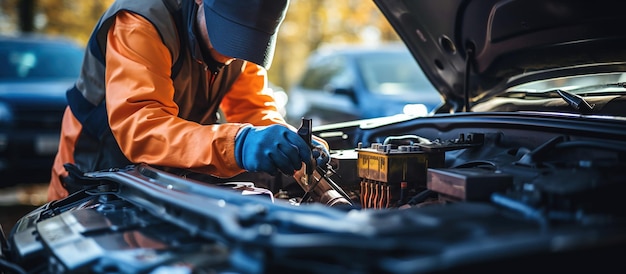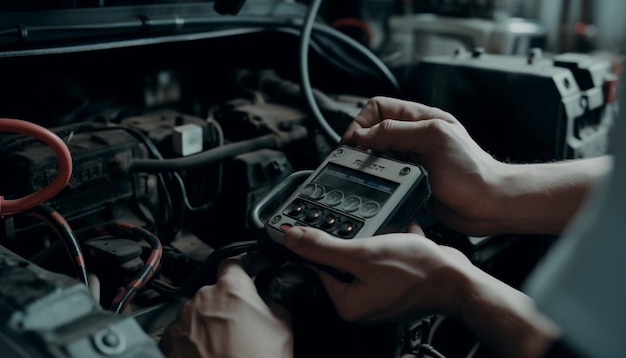
Dead Battery? Don't Panic!
Getting stranded with a dead battery can be frustrating, especially when you're in a rush or facing harsh weather conditions. But fear not! Jumpstarting your car is a relatively simple procedure that can get you back on the road in no time. This comprehensive guide will walk you through the entire process, including essential safety precautions, step-by-step instructions, troubleshooting tips, and winter considerations. Additionally, we'll address the unique aspects of jumpstarting lithium batteries, which are becoming increasingly common in modern vehicles.
Before You Begin: Safety First!
Safety is paramount when dealing with car batteries. They contain acid and can generate sparks, posing potential hazards. Here are some crucial safety tips to remember:
- Park both vehicles on a level, stable surface and ensure they are in Park (automatic) or Neutral (manual) with the parking brake engaged.
- Turn off both engines and all electrical accessories in both vehicles.
- Never smoke or allow sparks or flames near the battery, as hydrogen gas can be present and highly flammable.
- Wear eye protection and avoid touching your eyes while handling the battery cables.
- If you have any concerns or are unsure about any step, seek help from a professional.
Gathering the Essentials: What You'll Need
To jumpstart your car, you'll need the following:
- A good quality set of jumper cables: Ensure they are long enough to reach both batteries comfortably and have clamps that fit securely onto the battery terminals. Check the cable gauge; thicker cables are better for handling higher currents.
- A donor car with a fully charged battery: The donor car's battery voltage should ideally match yours (usually 12 volts).
- Optional: Safety glasses and gloves (recommended for added protection)
Step-by-Step Guide: Jumpstarting Your Car
- Park the cars facing each other, close enough for the jumper cables to reach, but without actually touching.
- Open the hoods of both vehicles and locate the batteries. The battery is typically housed in a plastic casing under the hood, often near the firewall (the barrier between the engine and passenger compartment).
- Identify the positive (+) and negative (-) terminals on each battery. The positive terminal is usually marked with a red color or a plus (+) sign, while the negative terminal is marked with black or a minus (-) sign.
- Unwind and inspect the jumper cables for any damage to the insulation. Ensure the clamps are clean and free of corrosion.
- Connect the red (+) clamp of the jumper cables to the positive (+) terminal of the dead battery.
- Connect the other red (+) clamp to the positive (+) terminal of the donor car's battery.
- Connect the black (-) clamp to the negative (-) terminal of the donor car's battery.
- ****Crucially, do not connect the black (-) clamp to the negative (-) terminal of the dead battery yet. Instead, find a clean, unpainted metal grounding point on the dead car's engine block, away from the battery and any fuel lines. This grounding point is often a bolt or bracket. Securely clamp the black (-) cable to this grounding point.
- Start the engine of the donor car and let it run for a few minutes. This allows the donor car's battery to charge the dead battery slightly.
- Try starting the car with the dead battery. If it starts successfully, let it run for at least 5 minutes to allow the alternator to recharge the battery further.
- Once the car with the dead battery is running consistently, disconnect the jumper cables in the reverse orderyou connected them:
- Black (-) clamp from the grounding point on the dead car.
- Black (-) clamp from the negative terminal of the donor car.
- Red (+) clamp from the positive terminal of the donor car.
- Red (+) clamp from the positive terminal of the dead car.
- Carefully close the hoods of both vehicles.
Troubleshooting: What if My Car Won't Start?
If your car doesn't start after following the steps above, there could be several reasons:
- The donor car's battery may not be strong enough. Try using a different donor car with a fully charged battery.
Jumpstarting Your Car: A Comprehensive Guide

tight.
- The dead battery may be too weak or completely dead. In this case, a jumpstart might not be enough, and you may need to replace the battery.
- There could be a deeper underlying issue with your car's electrical system. If the problem persists, consult a qualified mechanic for diagnosis and repair.
Winter Considerations: Jumpstarting in Cold Weather
Cold weather can significantly impact battery performance, making jumpstarting more challenging. Here are some additional tips for winter jumpstarting:
- Park the donor car in a warm garage or sheltered area, if possible, to keep its battery warm.
- Spend extra time allowing the donor car to run before attempting to start the dead car. This helps warm the donor battery and improve its cranking power.
- Consider using thicker gauge jumper cables (e.g., 4 gauge) as they can handle the increased current draw in cold weather.
Jumpstarting Lithium-Ion Batteries: What You Need to Know
Lithium-ion batteries are becoming increasingly common in hybrid and electric vehicles. While the jumpstarting process is generally similar, there are some important points to remember:
- Consult your car's owner's manual for specific instructions on jumpstarting. Different manufacturers may have varying procedures or designated jumpstart points.
- Never attempt to jumpstart a lithium-ion battery if the manual advises against it. Doing so could damage the battery and other electrical components in your car.
- If your car's manual allows jumpstarting, use only lithium-ion battery-compatible jumper cables. These cables may have built-in safety features to prevent damage to the sensitive battery.
In Conclusion
Jumpstarting your car can be a straightforward process with proper preparation and adherence to safety guidelines. Remember, safety is paramount, so always prioritize safe practices. If you encounter any difficulties or have concerns, seeking help from a qualified mechanic is always the best course of action. By following these steps and understanding the nuances of winter and lithium-ion battery considerations, you can confidently tackle a dead battery and get back on the road quickly and safely.
No comments:
Post a Comment